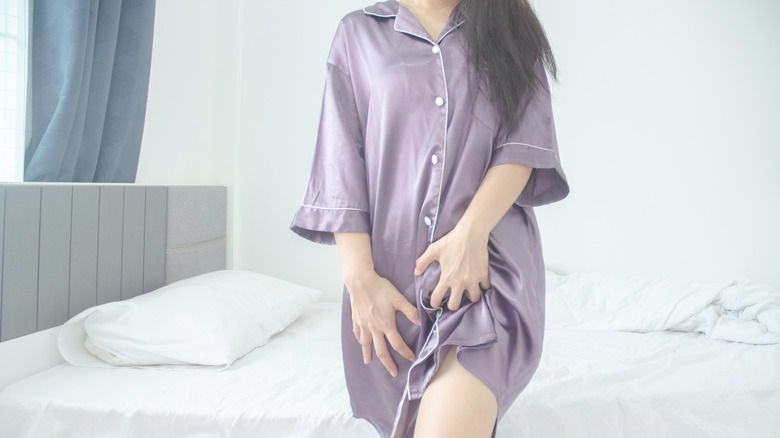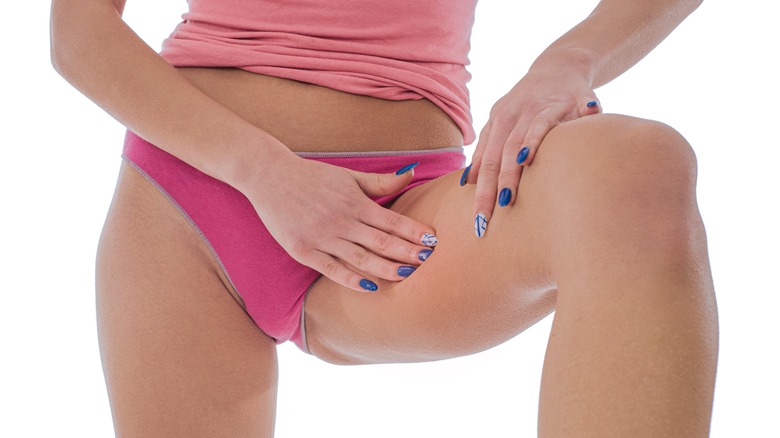What Is Jock Itch & How Can You Prevent It?
If you're athletic and love to run, kick, or swing at balls while wearing a tight-fitting team outfit and sweating like hell, you might get tinea crusis, the fancy name for jock itch. Or, if you're a pop star (like Adele) perspiring under the lights and belting out mega hits in front of thousands while dressed in Spanx, you might also get jock itch. It's an equal opportunity fungal infection, and, we'd like to remind you, nothing to be embarrassed about. Let's discuss it.
Under the right conditions, jock itch can happen to people of all genders. It's most common in men, possibly because men have historically been expected to play sports. Heat, sweat, tight clothing, and a type of fungi that live harmlessly on our skin normally (called dermatophytes) can come together in the groin area, thighs, and butt crack to cause jock itch. It develops in skin folds. Remember that jock itch is highly contagious and easily spreads to other parts of the body, though not to the genitals. If you've got it and are intimate with someone, they can get it too. Let this be the summer you're facing your most intimate concerns head-on. If the itching down there is intense, but it's not jock itch, we've got some remedies to get rid of sand and other under-discussed issues.
Jock itch symptoms
Although it's most common in hot, humid climates, if you're reproducing a hot, humid climate in your gym shorts, you can get jock itch at any location in the world. As a contagious fungal infection, it's considered a form of ringworm, but no worms are involved.
When light-skinned people get it, they usually see a red rash, and it can appear brown or gray on darker skin. You'll feel an intense urge to scratch because of the high itchiness level, and your skin might even feel like it's burning. The affected skin on the groin or upper thighs can become scaly or flakey. Bumps might form at the edge of the rash pattern. If you've got it on your thighs, the color might differ from leg to leg. Left untreated, it can spread to nails, hands, and feet. Although there are home treatments that remedy the condition, if you're at all concerned about identifying and treating it properly, visit your doctor for a diagnosis.
How to treat jock itch
It's worth noting that jock itch is so contagious, Dr. Jennifer Clements reminds us via GoodRx Health that the fungi "can live on objects for up to 18 months. Using an object that has fungi on it can undo all your hard work by reinfecting your skin. So, it's important to wash clothing, underwear, and towels after every use." Wear loose clothing to bed; if the infected area comes into contact with bedding, you'll need to wash your sheets after each use.
The recommendation is to immediately start applying a topical anti-fungal cream to the affected area. Terbinafine (Lamisil AT), Butenafine (Lotrimin Ultra), Tolnaftate (Tinactin), Clotrimazole (Lotrimin AF, Clotrimazole 3) and Miconazole are all cream options. Check the box for directions, but usually, you'll need a course of anti-fungal creams at least twice daily for a two-week period. If after that point the rash is still raging, see your doctor about an oral prescription, which may have side effects.
If you have to wear gloves to keep yourself from scratching, try it. Only wear loose-fitting clothes, including loose underwear. If you're concerned about finding cute looser options and want to stay stylish when the heat is on, we've got 12 tips. After you take a shower with a mild cleanser (don't irritate the rash by scrubbing; be gentle), dry the area thoroughly, and toss that used towel in the laundry bag. To prevent it, wear loose clothing, use anti-fungal powders, and remove wet clothes as soon as possible.


